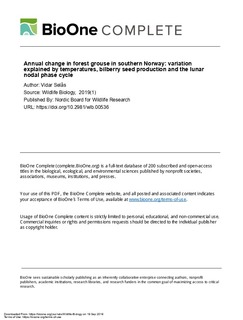| dc.contributor.author | Selås, Vidar | |
| dc.date.accessioned | 2019-09-20T09:29:45Z | |
| dc.date.available | 2019-09-20T09:29:45Z | |
| dc.date.created | 2019-09-19T13:40:48Z | |
| dc.date.issued | 2019 | |
| dc.identifier.citation | Wildlife Biology. 2019(1). | nb_NO |
| dc.identifier.issn | 0909-6396 | |
| dc.identifier.uri | http://hdl.handle.net/11250/2617990 | |
| dc.description.abstract | Forage quality is rarely the focus of studies on grouse performance. The plant stress hypothesis predicts that the protein digestibility of a focal food plant for grouse in Norway, the bilberry Vaccinium myrtillus should be highest after a peak in seed production. Protein digestibility may also be affected positively by cosmic ray (muon) fluxes, which fluctuate with the 9.3-year lunar nodal phase cycle, and negatively by high temperatures in the preceding summers. The annual change (first difference) in ln-transformed black grouse Tetrao tetrix and capercaillie T. urogallus hunting statistic indices from southern Norway 1999–2017 was positively related to the mean June temperature, which is assumed to have a direct positive impact on chick survival. In multiple regression models, there was also a positive relationship with the seed production of bilberry in the preceding year, the lunar nodal phase index with a two-year time lag, and a negative relationship with the combined mean June–September temperature of the two preceding years. Small rodent numbers did not contribute significantly in these models. In further monitoring of grouse populations, the seed production of bilberry or other important food plants should also be recorded. | nb_NO |
| dc.language.iso | eng | nb_NO |
| dc.rights | Attribution-NonCommercial-NoDerivatives 4.0 Internasjonal | * |
| dc.rights.uri | http://creativecommons.org/licenses/by-nc-nd/4.0/deed.no | * |
| dc.title | Annual change in forest grouse in southern Norway: variation explained by temperatures, bilberry seed production and the lunar nodal phase cycle | nb_NO |
| dc.type | Journal article | nb_NO |
| dc.type | Peer reviewed | nb_NO |
| dc.description.version | publishedVersion | nb_NO |
| dc.source.pagenumber | 9 | nb_NO |
| dc.source.volume | 2019 | nb_NO |
| dc.source.journal | Wildlife Biology | nb_NO |
| dc.identifier.doi | 10.2981/wlb.00536 | |
| dc.identifier.cristin | 1726759 | |
| cristin.unitcode | 192,14,0,0 | |
| cristin.unitname | Miljøvitenskap og naturforvaltning | |
| cristin.ispublished | true | |
| cristin.fulltext | original | |
| cristin.qualitycode | 1 | |

